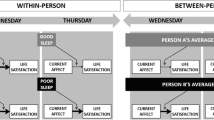Abstract
Background
Sensitivity to negative affect is considered the central defining characteristic of neuroticism and has been found to be associated with poor sleep quality.
Objectives
Following recent theories distinguishing between sensitivity to negative affect and the capacity to self-regulate affective states, this study aimed at demonstrating the potential impact of affect regulation on sleep quality.
Materials and methods
A total of 178 participants varying in their sleep quality participated in an Internet-based questionnaire study assessing sleep quality, neuroticism, self-regulating coping style (action/state orientation), and a series of control variables.
Results
In line with assumptions, individuals scoring high in neuroticism were only impaired in sleep quality if they were also characterized by a state-oriented coping style or—stated differently—the negative impact of neuroticism on sleep quality could be dampened by higher action orientation. The effect remained after controlling for depression, anxiety, and age.
Conclusions
The results preliminarily highlight the importance of self-regulation, i. e., affect regulation, in the understanding of poor sleep quality.
Zusammenfassung
Hintergrund
Die Empfindsamkeit gegenüber negativem Affekt wird als zentrales, definierendes Charakteristikum für Neurotizismus angesehen und geht einher mit schlechter selbstberichteter Schlafqualität.
Fragestellung
Nach neueren Theorien, die zwischen affektiver Sensitivität und Affektregulation unterscheiden, möchte die vorgestellte Studie die Bedeutung dieser Unterscheidung für das Verständnis schlechter Schlafqualität untersuchen.
Material und Methoden
Insgesamt nahmen N = 178 Versuchspersonen mit unterschiedlicher Schlafqualität an einer internetbasierten Umfrage teil. Erfasst wurden Schlafqualität, Neurotizismus, die Selbststeuerungsfähigkeit (Handlungs‑/Lageorientierung) und eine Reihe von Kontrollvariablen.
Ergebnisse
Erwartungsgemäß waren Teilnehmende mit hohen Neurotizismuswerten nur dann in ihrer Schlafqualität beeinträchtigt, wenn sie sich gleichzeitig durch einen lageorientierten Coping-Stil auszeichnen. Somit konnte der negative Einfluss von Neurotizismus auf die Schlafqualität durch einen stärker handlungsorientierten Coping-Stil ausgeglichen werden. Die Ergebnisse blieben auch nach Kontrolle von Depression, Angst und Alter bestehen.
Diskussion
Die Ergebnisse geben erste Hinweise auf die Relevanz von Selbst- bzw. Affektregulation für das Verständnis schlechter Schlafqualität.

Similar content being viewed by others
References
Austin PC (2008) Using the bootstrap to improve estimation and confidence intervals for regression coefficients selected using backwards variable elimination. Stat Med 27:3286–3300
Baron RM, Kenny DA (1986) The moderator-mediator variable distinction in social psychological research: Conceptual, strategic, and statistical considerations. J Pers Soc Psychol 51:1173–1182
Baumann N, Kuhl J (2002) Intuition, affect, and personality: Unconscious coherence judgements and self-regulation of negative affect. J Pers Soc Psychol 83:1213–1223
Baumann N, Kaschel R, Kuhl J (2007) Affect sensitivity and affect regulation in dealing with positive and negative affect. J Res Pers 41:239–248
Beck AT, Steer RA (1987) Beck Depression Inventory – Manual. The Psychological Association, San Antonio
Brunstein JC (2001) Persönliche Ziele und Handlungs- versus Lageorientierung: Wer bindet sich an realistische und bedürfniskongruente Ziele? [Personal goals and action versus state orientation: Who builds a commitment to realistic and need-congruent goals?]. Z Differ Diagn Psychol 22:1–12
Buysse DJ, Reynolds CF, Monk TH et al (1989) The Pittsburgh Sleep Quality Index: A new instrument for psychiatric practice and research. Psychiatry Res 28:193–213
Clark LA, Watson D, Mineka S (1994) Temperament, personality, and the mood and anxiety disorders. J Abnorm Psychol 103:103–116
Coren S (1988) Prediction of insomnia from arousability predisposition scores: scale development and cross-validation. Behav Res Ther 26:415–420
Costa PT Jr., Mccrae RR (1985) The NEO Personality Inventory manual. Psychological Assessment Resources, Odessa, FL
Diefendorff JM, Hall RJ, Lord RG et al (2000) Action-state orientation: Construct validity of a revised measure and its relationship to work-related variables. J Appl Psychol 85:250–263
Espie CA (2002) Insomnia: Conceptual issues in the development, persistence, and treatment of sleep disorder in adults. Annu Rev Psychol 53:215–243
Fernández-Mendoza J, Vela-Bueno A, Vgontzas AN et al (2010) Cognitive-emotional hyperarousal as a premorbid characteristic of individuals vulnerable to insomnia. Psychosom Med 72:397–403
Fisher PL, Durham RC (1999) Recovery rates in generalized anxiety disorder following psychological therapy: An analysis of clinically significant change in the STAIT across outcome studies since 1990. Psychol Med 29:1425–1434
Gieselmann A, Ophey M, De Jong-Meyer R et al (2012) An induced emotional stressor differentially decreases subjective sleep quality in state-oriented but not in action-oriented individuals. Pers Individ Dif 53:1007–1011
Gross JJ (2001) Emotion regulation in adulthood: Timing is everything. Curr Dir Psychol Sci 10:214–219
Hall M, Buysse DJ, Nowell PD et al (2000) Symptoms of stress and depression as correlates of sleep in primary insomnia. Psychosom Med 62:227–230
Hardt J, Gerbershagen HU (2001) Cross-validation of the SCL-27: a short psychometric screening instrument for chronic pain patients. Eur J Pain 5:187–197
Hohagen F, Rink K, Käppler C et al (1993) Prevalence and treatment of insomnia in general practice. Eur Arch Psychiatry Clin Neurosci 251:49–56
de Jong-Meyer R, Schmitz S, Ehlker M et al (1999) Handlungsorientierte Interaktionsbeiträge in verschiedenen Therapien: Prozesssteuerung und Erfolgsrelevanz [Action-oriented interactions in different therapies: Process control and result relevance. Z Klin Psychol Psychiatr Psychother 47:172–190
Koole SL (2009) The psychology of emotion regulation: An integrative review. Cogn Emot 23:4–41
Kuhl J (1994) Action versus state orientation: Psychometric properties of the Action Control Scale (ACS-90). In: Kuhl J, Beckmann J (eds) Volition and Personality: Action versus State Orientation. Hogrefe & Huber, Göttingen, pp 47–59
Kuhl J, Beckmann J (eds) (1994) Volition and personality: Action versus state orientation. Hogrefe & Huber, Göttingen, Germany
Kuhl J, Fuhrmann A (1998) Decomposing self-regulation and self-control: The Volitional Component Inventory. In: Heckhausen J, Dweck CS (eds) Motivation and Self-Regulation across the Life-Span. University Press, Cambridge, pp 15–45
Van De Laar Verbeek Pevernagie MID et al (2010) The role of personality traits in insomnia. Sleep Med Rev 14:61–68
Lichstein KL, Rosenthal TL (1980) Insomniacs’ perceptions of cognitive versus somatic determinants of sleep disturbance. J Abnorm Psychol 89:105–107
Lundh L‑G, Broman J‑E, Hetta J (1995) Personality traits in patients with persistent insomnia. Pers Individ Dif 18:393–403
Morin CM, Rodrigue S, Ivers H (2003) Role of stress, arousal, and coping skills in primary insomnia. Psychosom Med 65:259–267
O’Connor BP (1998) All-in-one programs for exploring interactions in moderated multiple regression. Educ Psychol Meas 58:833–837
Ong AD, Exner-Cortens D, Riffin C et al (2013) Linking stable and dynamic features of positive affect to sleep. Ann Behav Med 46:52–61
Riemann D, Spiegelhalder K, Feige B, Voderholzer U, Perlis M, Nissen C (2010) The hyperarousal model of insomnia: A review of the concept and its evidence. Sleep Med Rev 14:19–31
Roth T, Kramer M, Lutz T (1976) The nature of insomnia: A descriptive summary of a sleep clinic population. Compr Psychiatry 17:217–220
Spielberger CD, Gorsuch RL, Lushene RE (1970) Test Manual for the State-Trait Anxiety Inventory. Consulting Psychologist Press, Palo Alto
Taylor DJ, Lichstein KL, Durrence HH et al (2005) Epidemiology of insomnia, depression, and anxiety. Sleep 28:1457–1464
Voss U, Kolling T, Heidenreich T (2006) Role of monitoring and blunting coping styles in primary insomnia. Psychosom Med 68:110–115
Watts FN, East MP, Coyle K (1995) Insomniacs’ perceived lack of control over sleep. Psychol Health 10:81–95
West SG, Aiken LS, Krull JL (1996) Experimental personality designs: Analyzing categorical by continuous variable interactions. J Pers 64:1–48
Wittchen H‑U, Jacobi F, Rehm J et al (2011) The size and burden of mental disorders and other disorders of the brain in Europe 2010. Eur Neuropsychopharmacol 21:655–679
Zhang B, Wing YK (2006) Sex differences in insomnia: A meta-analysis. Sleep 29:85–93
Author information
Authors and Affiliations
Corresponding author
Ethics declarations
Conflict of interest
A. Gieselmann, R. de Jong-Meyer and R. Pietrowsky declare that they have no competing interests.
All procedures performed in the reported study involving human participants were in accordance with the ethical standards of the institutional research committee and with the 1964 Helsinki declaration and its later amendments.
Rights and permissions
About this article
Cite this article
Gieselmann, A., de Jong-Meyer, R. & Pietrowsky, R. Sleep quality and self-regulation. Somnologie 22, 2–9 (2018). https://doi.org/10.1007/s11818-017-0137-1
Received:
Accepted:
Published:
Issue Date:
DOI: https://doi.org/10.1007/s11818-017-0137-1




